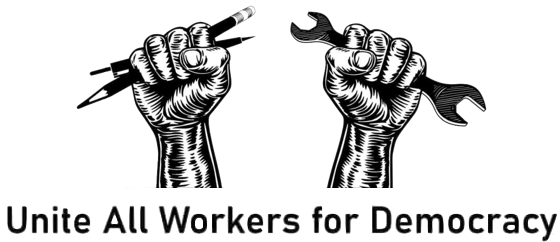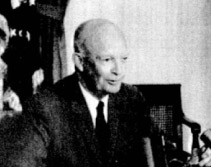Follow Erik Loomis on Twitter
Read Erik Loomis on Lawyers, Guns, & Money
Historian Erik Loomis on This Day in Labor History: September 14, 1959. President Eisenhower signed the Landrum-Griffin Act after actively lobbying for its passage. It used union corruption as an excuse for a broad-based attack upon organized labor on issues completely unrelated to corruption.
There is a wide scale public perception of union corruption. Mostly, this is false and a corporate promoted narrative to turn people off of organizing themselves to improve their lives. But with some unions, corruption was (and occasionally still today, is) all too real.
In general, this corruption was concentrated in some of the AFL trades, mostly the smaller building trades unions but also of course in the International Brotherhood of Teamsters. Teamsters corruption is largely associated with Jimmy Hoffa.
This is not wrong and Hoffa was certainly on the take himself, but it’s actually quite a bit more complicated that that. First, the IBT had major corruption issues before Hoffa took power. Second, the corruption reached deep into several sectors of the union.
The Teamsters had real problems here and earned their reputation, although the problem is less severe today. The AFL version of the United Auto Workers (UAW-AFL–basically the offshoot of UAW locals angry over internal politics in the real UAW) had real problems.
John Dioguardi, a high ranked member of the Lucchese crime family was named head of UAW-AFL Local 102 in New York. Distillery Workers Union executive Sol Cilento was indicted on bribery and conspiracy charges.
These sorts of problems got the attention of politicians. It is worth remembering that outside of union-dense areas, organized labor was extremely unpopular in the United States, giving politicians in the South, Great Plains, and West no reason not to go after unions.
It also allowed politicians from the union-heavy areas to raise their national profile by showing they would buck unions at some risk to their careers.
Anti-corruption hearings in Congress settled in the McClellan Committee, named after its chair, Senator John McClellan, a Democrat from Arkansas.
The McClellan Committee originally investigated corruption charges against both business and labor but soon shifted to a Senate committee devoted exclusively to digging into the dark side of organized labor.
After the 1958 congressional election, in which Democrats picked up large gains in both chambers, conservatives raised fears of communistic and corrupt unions would rule America.
Introducing the law was two congressmen–Philip Landrum, a Georgia Democrat, and Michigan Republican John Griffin.
This “bipartisanship” that so many Beltway hacks long for today ignores the fact that the real control in Congress belonged to people who shared very similar conservative positions on many issues, regardless of party registration.
The law mandated unions hold internal elections, barred members of the Communist Party from holding union office for five years after they left the CPUSA, required that unions submit annual financial reports, and limited power to put locals into trusteeship.
Effectively, Landrum-Griffin used corruption as an excuse to extend the anti-union provisions of the Taft-Hartley Act.
Legislation could have dealt with actual corrupt unions rather than serve as a general attack on organized labor, but that was not the point for the legislators involved. They wanted to bust unions.
Organized labor as a whole vociferously opposed Landrum-Griffin. This isn’t because the AFL-CIO didn’t oppose corruption. As a whole, the federation very much did. It also kicked three particularly corrupt unions out of the federation, including the Teamsters.
Organized labor was opposed to the act because the bill’s authors used it as a broader attack upon unions, forcing them into reporting requirements that business did not have to adhere to.
In other words, it was a major step in tipping a playing field only twenty years earlier evened for workers back toward employers. What on earth did communism have to do with corruption? Nothing of course, but it didn’t matter.
Politically of course, it was brilliant to force labor to oppose Landrum-Griffin because they then looked pro-corruption to the general public.
Some senators who had made their name fighting union corruption were not happy that the bill attacked the heart of unions. That included John F. Kennedy, who had introduced his own anti-corruption bill.
Said Robert Kennedy, chief counsel to McClellan, Landrum-Griffin went “beyond the scope of the McClellan Committee’s findings to affect the economic balance at the bargaining table by honest and legitimate unions and employers.”
What made Landrum-Griffin beat Kennedy’s bill was President Dwight Eisenhower giving a national speech on September 3 to urge its passage. Congress soon did and Eisenhower signed the law on September 14, 1959.
A fascinating side note to the origins of Landrum-Griffin. David Witwer’s recent research that shows the public incident that led to its passage was largely fabricated. In 1956, the anti-union newspaper columnist Victor Riesel was blinded when the mob threw acid in his eyes.
The story was that the corrupt unions did it as revenge for his writing about the “underworld-Communist combine” in his column and to prevent him from testifying against union corruption. It was this act that led to the McClellan Committee.
The FBI arrested UAW-AFL Local 102 head John Diogaurdi for ordering the hit. Dioguardi was a mobster running a union for personal profit. This general narrative of bad union thugs attacking hero Riesel for his brave crusade has remained largely unchallenged until recently.
However, Witwer shows that in fact, Riesel never wrote about Dioguardi or any of his operations. Instead, it seems Riesel was corrupt himself and had a financial arrangement with Dioguardi so that he would not write about the mobster.
Union leaders’ testimony to the FBI shows that Riesel was shaking down the corrupt unions to keep their names out of his columns. Dioguardi and Riesel even partied together at mob restaurants in New York’s garment district.
Witwer could not find out exactly why Dioguardi ordered the hit on Riesel. He suggests it may have had something to do with a dispute over the financial arrangements between the two in another shakedown–forcing businesses to pay up to stay union free.
All the big political players, including the U.S. Attorney, FBI, and the McClellan Committee, found out about Riesel’s double dealings and lies as he couldn’t or wouldn’t answer a lot of questions when they talked to him.
But Riesel was too useful in the larger anti-union movement to bother with the truth mattering much. Riesel played the martyr until the day he died. Fascinating stuff.
Two points to conclude. First, it is worth noting that this took place at the time when unions had the most power they ever had in American history. For all those who claim, sometimes rightfully, that the labor movement doesn’t use its power, note this.
The use of union political power itself can lead to backlash and organized labor has never been strong enough in enough states to really express that power without serious consequence.
Second, what makes this law so atrocious is not the anti-corruption provisions. I think we can all agree that union corruption is bad. It’s that business has always been FAR more corrupt than unions. But that goes untouched, all the way to the grifter in the White House today.

